Hawksbeards. Yellow Composites ID article
The Hawksbeards ( Crepis) species group are difficult to identify.
Crepis capillaris Smooth Hawksbeard
Crepis vesicaria Beaked Hawksbeard
Crepis biennis Rough Hawksbeard
Separating Beaked from Rough Hawksbeard can prove a challenge.
Fortunately they do not hybridise so we are left with just variation to contend with. They also look similar to other yellow composites, especially the Hawkweed group. The Crepis group ( well at least the three covered here) has two rows of involucre bracts (called phyllaries in Stace) , the outer being spread out, whereas the Hawkweeds tend to have all the bracts held tight and in more rows.
 |
| Hawkweed ( Burren, Ireland) |
 |
| Hawkweed ( Royston, UK) |
 |
| Crepis vesicaria ( Cambridge) |
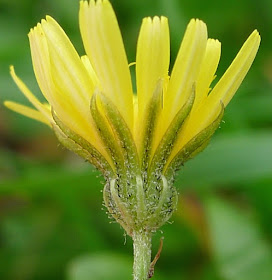 |
| Crepis capillaris ( Cambridge) |
The similar feature with Crepis and Hieracium ( Hawkweed) at least in terms of flowers heads is:-
Dark (sometimes glandular) hairs ( simple , no splits)
White hairs (sometimes glandular) ( simple no splits)
Cobwebby white hairs ( arachnoid hairs).
Differences are outer bracts spreading and white pappus hairs in Crepis. Achenes are very different.
Hawkweeds are an even more difficult group than Crepis and are only mentioned in passing as they need to be excluded first.
1) Crepis distribution.
The three species covered here are wide spread in the UK, Smooth Hawksbeard ( Crepis capillaris) is very common throughout Britain and Ireland, Beaked Hawksbeard ( Crepis vesicaria ) is common in England and Wales but less so in the North but present in Ireland whereas Rough Hawksbeard (Crepis biennis)has a much more patchy distribution mainly in England and some in Ireland.
There are two other species with more northern distributions not covered here Crepis paludosa, Marsh Hawksbeard and Crepis mollie, Northern Hawksbeard which are well covered in the excellent blog which also includes comparison with Hawkweed :-
cumbriabotany.co.uk. Article on Northern Hawk's-beard (left side menu).
2) Structure.
The basic structure is one or more major stems splitting into branches with numerous flowering heads and with leaves at the base and at branching points. Size can be highly variable especially Crepis capillaris which can have robust large plants up to one meter high or can be tiny lawn plants just a few cm high. Crepis capillaris is generally a more slender plant.
 |
| Crepis capilllaris ( Rampton) |
 |
| Crepis vesicaria ( Rampton) |
 |
| Crepis biennis ( Cottenham) |
The really easy way to separate these three species is to look at their achenes ( seeds) which have very different shapes.
 |
| Crepis capillaris |
 |
| Crepis capillaris, |
 |
| Crepis capillaris (9 July 16 Grantchester) |
Crepis vesicaria. ( Beaked Hawksbeard)
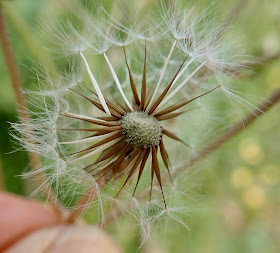 |
| Crepis vesicaria ( Longstanton, Cambs) |
 |
| Crepis vesicaria ( Cottenham, Cambs) |
 |
| Close up of receptacle and beaked achene. |
 |
| C. biennis (Rampton 18th June 17) |
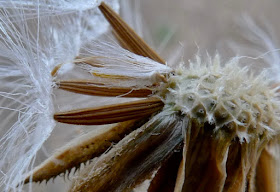 |
| C. biennis (Rampton Guided Bus Way 4th Jul 17 ) |
This is fine except that very often you find flowering plants that have not reached the stage where the achenes have developed. One feature is to see if the shape of the achenes is apparent when the flower is developing. Time to look at the flowers.
4) Flowers. Top View
4a) Crepis capillaris. Smooth Hawksbeard
 |
| C. capillaris (22 Jul 18 ) Note Yellow Stigma don't stand out against the petals. |
C capillaris have quite small flowers, similar to the flowers of Nipplewort, being 8-15mm across ( robust form up to 20mm) and this is a important ID feature. C. vesicaria can have similar sized flowers and C. biennis have much larger flowers heads and often appear more ragged compared to the neater capillaris. Outer banding can be reddish in some plants.
 |
| C. capillaris 14Jul18 |
4b) Crepis vesicaria. Beaked Hawksbeard
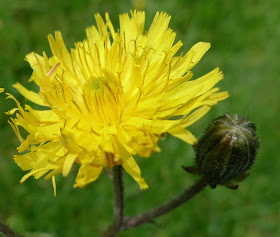 |
| C. vesicaria ( 2 May 15) Greenish Yellow style and stigma. |
 |
| C. vesicaria ( 10 Jun 18, Royston) stigma greenish. |
The flowers are 15-40mm across often the outer petals having reddish ( or white) banding on outer face. Tip can show red. May have more petals than C capillaris, but generally more ragged than capillaris.
 |
| C vesicaria (13May18 Soham) |
4c) Crepis biennis Rough Hawksbeard.
 |
| C. biennis ( 9Jun18) Note Yellow style and sigma |
 |
| C. biennis (9Jun18 Longstanton, Cambs) |
The second flower is more mature but still shows completely yellow stigma and style. The petals are completely yellow with no reddish banding. The two features are worth checking as they seem to be reliable. Flower across 30-45mm. much bigger than C. vesicaria.
 |
| C biennis ( 2Jun18 Great Eversden, Cambs.) |
5) Flowers Side View showing involucral bracts.
5a) C. capillaris. Smooth Hawksbeard
 |
| C. capillaris ( 22Oct15) |
Typical flower showing the outer bracts spreading and curving back into touching the inner bracts.
Occasionally the outer bracts stay close in ( appressed), not spreading.The outer bracts are thin and are hairless except for slight a cobwebby ( arachnoid) hairs. They are about a third in length of the inner bracts which have short black hairs mainly on or close to the centre line plus the white cobwebby hairs.
 |
| C capillaris (14Jul18) |
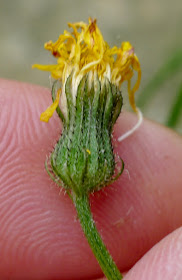 |
| C capillaris ( 30 Jun 16) |
Note the best image but the only photo I have a of the robust form of C. capillaris Structure conforms to the examples above. Note slight red banding on our petals.
5b) C. vesicaria Beaked Hawksbeard.
 |
| C. vesicaria (10Jun18 Royston) |
Red banding on outer petals. Cobwebby ( arachnoid ) white hairs present plus the black stout hairs and some longer white hairs with glandular tips.
The outer bracts are wider and stronger looking than C capellaris but very similar to C. biennis.
A marginal difference is the outer bracts have very pale white edging which is clear in this example.
 |
| Red banding prominent ( 12 Jun16) |
 |
| C. vesicaria (2Jun16) |
This example is chosen as the cobwebby hairs are prominent but it almost lacks the stout black hairs which are tiny and the long white hairs which are more typical. An example of variation.
 |
| Cut flower, late stage |
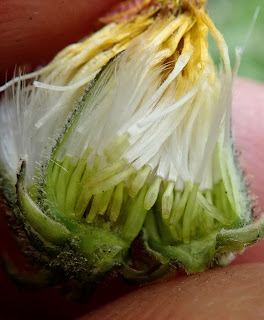 |
| Cut Flower, early stage |
It is possible to see the shape of the achene before the flower develops in the pappus stage. The late stage photo clearly shows the beaked achenes forming but the early stage also shows the achenes thinning down just before the pappus hairs. This is not always so clear cut as the achenes on the left are not showing this feature as well as the ones in the centre of the photo.
5c) C. biennis Rough Hawksbeard.
 |
| C. biennis 31May14 |
Outer bracts are very robust and have a dark centre line in this particular plant. Cobwebby hairs as usual plus some stout black hairs. Pale yellow petals without red banding. The outer bracts tend to stick out rather than curve inwards and they also tend to a pale green rather than white at the margin.
 |
| C. biennis 22May16 |
This example lacks the dark centre line on the outer bracts. The outer bracts do not start at the same height on the stem. This is quite common in all three species. This plant also is showing the pale green edging to the outer bracts.
 |
| C. biennis 9Jun18 |
Achene shape is well developed at the post petal stage. No sign of beaking.
 |
| C. biennis 25Jun18 |
Petals have faded but at this stage achene shape without beaking is apparent.
The shape of the developing achenes are probably a more reliable feature than the appearance of the bracts or leaf shape or colour of the sap.
6) Leaf shape.
C capillaris.
 |
| C capillaris Lower leaf shape with thin protrusions at right angles. |
 |
| C. capliiaris (30Jun16) Basal leaves. Robust plant. |
 |
| Basal leaf without 90Deg points |


 |
| C. capillaris (9 Jun18) |
A common feature in all three species is that the stem can be green or can have bright red lines running up. Some populations have about a 50/50 split with half the plants having completely green stems and the other half having the red lined stems.
C vesicaria
 |
| C vesicaria Mid stem leaf (10Jun18) |
 |
| C vesicaria 13May18 (Soham) |
Leaf shape is complex and very variable. It must be very hard to describe some of the complex shapes using words. I am not convinced leaf shape is much help when separating C vesicaria from C biennis. The photo below shows how spiky they can be, mid stem example.
C biennis.
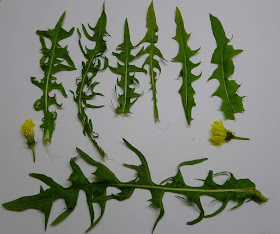 |
| Lower leaves |
 |
| C biennis Lower Leaf |
Just when you might think a pattern or feature is apparent, a leaf will come up that breaks the rule. The only conclusion I have come to is Crepis biennis can have the most variable complex leaf shape
possible and that may be a feature in itself. Using leaf shape to distinguish between C vesicaria and C biennis is beyond me.
7) Sap Colour
The sap colour of Crepis vesicaria is noted as bluish-white and Crepis biennis as yellowish-white in Harrap's Wild Flowers.
 |
| C vesicaria (3Jun18) |
 |
| C biennis (21Jun16) |
In practice the difference in sap colour may not be as pronounced as in the photos above but to date seems to be a reliable feature.
8) Conclusion
The above photos give the basic difference between the three species. This blog does not fully cover the variation and problems with plants that have been cut down and re-grown. Achene shape is the gold standard feature even if looked for in flowers that are still in bloom.
C. biennis seems to never have red banding that is often present in C. vesicaria. C. vesicaria often flowers about two-three weeks before C. biennis.
Stem leaves with pointed lobes at the base is a good feature for Crepis capillaris together with the lower leaf protrusions at 90degrees. As usual with difficult species as many features as possible need to be considered as plants are variable. A table follows as a trial key ID feature test. This will be used to see if these features always stack up or are not reliable in 2019.
An example of extreme variation, the last photo below is of a flower taken in Baltimore, County Cork which is an example of C. capillaris which had been cut down and regrown. Definitely one for the expert who confirmed its identification to me, based on several photos showing the leaves with the 90 degree protrusions. A very strange plant which shows not all plants have read the Flower Guide Books.
Crepis capillaris is the most variable of these species and is worth getting familiar with.
 |
| 9May2015(Baltimore, Co Cork) |
Summary. Features to be tested in the spring and summer 2019 to determine how useful they really are.
Any comments and corrections always welcome. Crepis vesicaria flower during May in Cambridgeshire, whereas Crepis biennis starts flowering at the very end of May.
Some comments that the flower size of biennis is pretty conclusive enabling ID to be made out of the car window and this is probably true. Hight is often a factor where biennis can be much taller but this is not always true. Sap colour may not be 100% as some biennis have quite white sap which may only just show the yellow tinge after about a minute.
A comparison of flower size follows. In this case capillaris is not so different to the flower of vesicaria , but biennis is about 38mm across.
Peter Leonard
Any comments and corrections always welcome. Crepis vesicaria flower during May in Cambridgeshire, whereas Crepis biennis starts flowering at the very end of May.
Some comments that the flower size of biennis is pretty conclusive enabling ID to be made out of the car window and this is probably true. Hight is often a factor where biennis can be much taller but this is not always true. Sap colour may not be 100% as some biennis have quite white sap which may only just show the yellow tinge after about a minute.
A comparison of flower size follows. In this case capillaris is not so different to the flower of vesicaria , but biennis is about 38mm across.
Rampton, Cambridgeshire
16 Feb 2019 updated 5th June 2019

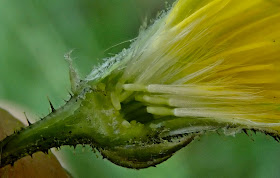









Thank you for sharing your experience and knowledge, that's very helpful. Has your spell-checker been changing 'capillaris' to 'capillaries' at a few points in the blog? It's a bit confusing. But as I said, thank you, very useful.
ReplyDeleteI've just managed to identify a seed head that I shot yesterday by reference to your splendid photos. A very useful page, Thanks!
ReplyDeleteOh, Beaked Hawksbeard... never knowingly encountered their seedhead before!
Does it attract any species of insect or animal? If it does could you say? It would be very helpful!
ReplyDeleteWhat a tremendous synopsis of the three species. As a beginner with hawksbeards and hawkweed, I must thank you. This is most helpful.
ReplyDeleteIt would be great to include medicinal properties of Crepis too.
ReplyDelete